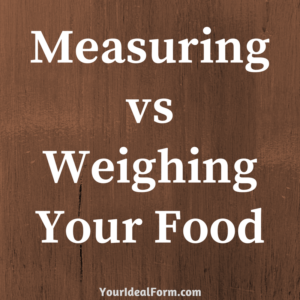
Weight loss pretty much boils down to eating fewer calories than your body burns in a day. It’s not about just eating some random amount “less” than before, you have to eat below your TDEE. And in order to do that, you have to know how much you are eating. This is where tracking comes into play. The more exact you can be, the quicker you will see results.
The scale of food tracking, from best to worst:
- Weighing everything out
- Measuring with spoons and cups
- Eyeballing it and guessing how much
- Basic tracking where you just write down what was eaten, not how much
- Not logging anything at all
I’d like to make the case for weighing your food rather than measuring it imprecisely. However, if you have obsessive tendencies, and this will worsen that or trigger an eating disorder, please don’t.
Buy a kitchen scale and USE it
Having a kitchen scale will give you the most accurate picture of how much you are eating. Keep it out on the counter so it is easy to use. You won’t use it if you have to dig it out of a cupboard each time you need it. Get used to using that “tare” button that zeroes out the scale. Need to measure peanut butter for a sandwich? You don’t have to dirty a separate utensil. Just put the plate and bread on the scale, and hit the tare button. Now pick up the bread and spread on the peanut butter. (The scale should go negative) Once your bread is (peanut) buttered, place it back down on the plate, and record the amount. Now you can hit the tare button again, and add more ingredients.
Guessing just leads to frustration
There are countless articles and infographics out there about guesstimating how much food you are eating. Sometimes this is really useful; for example if you are eating at someone else’s house. (Most restaurants these days post their nutrition information online if not right on the menu, so you can just look up the numbers there) But often, these guesses aren’t very clear. How much is a “handful” exactly? Should I be able to completely close my hand around it, or is it as much as I can possibly grab without any more falling through my fingers? And whose hand? I have relatively small hands, does this mean I should grab more? Should someone with larger hands grab less? And what do you do when it tells you that a “serving” of meat is the size of your palm, but doesn’t tell you how many grams or ounces that is?
Weighing is most accurate
You don’t want to be inadvertently consuming more calories than you actually logged. This leads to slower progress, and frustration when the scale doesn’t reflect what you think it should. Certain foods can be difficult to measure. And measuring requires dirtying whatever implement you are using to measure in the first place. With weighing, you can just put things on the plate you are going to use anyway, and just use the tare button to zero out the scale between different items. Weighing also keeps you honest. You might grab a heaping spoonful of peanut butter, and mark it down as 1 teaspoon. Weighing will tell you exactly how many grams it is, regardless of whether that spoon was made by Oneida, Mikasa or IKEA.
Being honest and accurate with your logging is the fastest way to get results.